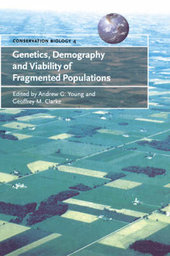
|
Genetics, Demography and Viability of Fragmented Populations
Hardback
Main Details
| Title |
Genetics, Demography and Viability of Fragmented Populations
|
| Authors and Contributors |
Edited by Andrew G. Young
|
|
Edited by Geoffrey M. Clarke
|
| Series | Conservation Biology |
|---|
| Physical Properties |
| Format:Hardback | | Pages:460 | | Dimensions(mm): Height 236,Width 156 |
|
| Category/Genre | Ecological science
Genetics (non-medical) |
|---|
| ISBN/Barcode |
9780521782074
|
| Classifications | Dewey:576.58 |
|---|
| Audience | | Professional & Vocational | |
|---|
| Illustrations |
34 Tables, unspecified; 2 Halftones, unspecified; 67 Line drawings, unspecified
|
|
Publishing Details |
| Publisher |
Cambridge University Press
|
| Imprint |
Cambridge University Press
|
| Publication Date |
12 October 2000 |
| Publication Country |
United Kingdom
|
Description
Habitat fragmentation is one of the most ubiquitous and serious environmental threats confronting the long-term survival of plant and animal species worldwide. As species become restricted to remnant habitats, effective management for long-term conservation requires a quantitative understanding of the genetic and demographic effects of habitat fragmentation, and the implications for population viability. This book provides a detailed introduction to the genetic and demographic issues relevant to the conservation of fragmented populations such as demographic stochasticity, genetic erosion, inbreeding, metapopulation biology, and population viability analysis. The volume presents case studies on animals and plants, which illustrate a variety of approaches to examining long-term population viability. Some of the approaches include the application of molecular genetic markers, the investigation of reproductive biology, and the combination of demographic monitoring and modeling.
Reviews'I really enjoyed some of the case studies ... understanding deterministic decline and its cure represents the greatest challenges to conservation biology. However, Clarke and Young show that understanding small-population processes might help maintain populations until 'the patient' can be cured.' Ken Norris, Biologist
|